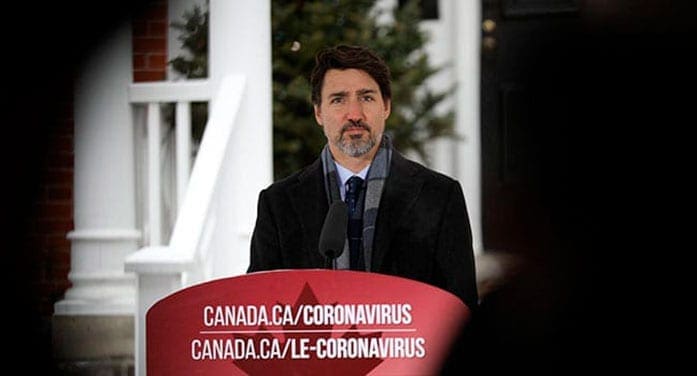 Head of government: “… and so stay safe.”
Head of government: “… and so stay safe.”
(Long pause.)
Robotic voice: “Our next caller is Scoop Notepad from the Daily Planet.”
Scoop: “Hi.”
Head of government: “Hi Scoop.”
(Pause. Sometimes the greetings are reversed.)
Scoop asks a question, head of government responds and then we hear the oddball, robotic voice again. Who is that?
Whomever it is (phone company employee, teleconferencing service), that voice doesn’t belong.
Have you ever seen or heard a version of the technique being used in real radio and TV, or even audio or video podcasts? No.
Skill testing questions:
- What did CNN’s Larry King do on his open-line show? “Tuscaloosa … you’re on the air.”
- What did CJOR’s Jack Webster say? “Line 1 – you’re on the air.”
Some might occasionally say, “Let’s go to the phone lines …” but they always used a short, snappy transition.
- How did Jack Webster sometimes end a call? “Uk, you’re daft, get off the line.” (Not advised for politicians. Daft people might take offence.)
- How did Pat Burns end a call? “Gotta go doll, goodbye.” (Not advised today.)
Yes, some hosts obsequiously ended with “I thank you for your call,” and other incredible thanks for modest input.
Traditional radio talk show hosts, later simulcast on TV, moved the program along quickly and didn’t have an unknown voice pop in to help them out.
For trivia buffs, Joe Pine in Montreal had John Tennant, later a stellar Canadian diplomat, read the news on his show, but he handled the callers himself – as did others.
Later, Pat Burns ruled the airwaves in Vancouver, Montreal and then Vancouver again. Around the time I was working with Jack Webster in Vancouver, he migrated to TV, and Ron Pumphrey on the other side of the country (St. John’s) ruled the airwaves, transmitted nicely through sideways rain.
In the middle of the country, Sherv Shragge (real name) worked the airwaves via the equally alliterative CKCK Radio and later migrated to Shragge’s Journal on CBC TV. Sherv is now writing insightful articles for the Regina Leader-Post, and happily he and I have reconnected after briefly working together in the last century. Sherv was hired, coached and assigned by both Burns and Webster.
But I digress, as I did when I hosted open line shows.
Later in the history of the genre, some hosts had sidekicks. Howard Stern’s sidekick would jump in with a comment or question, or Howard would ask the sidekick a question. But this character was developed over time, and listeners and viewers of the simulcast knew the routine.
So two questions:
- Who is that robotic, disembodied voice in COVID-19 news conferences?
- Have you ever heard an open-line broadcast use this odd technique?
No, you haven’t heard this technique. In fact, the technology I’ve used from hotel rooms thousands of kilometres away from the target audience allows me to host a town hall live with a guest and callers. It’s a click of the mouse to get a caller on or off. I can see what city or town the caller is from and use that in my transition. Or a screener can get a short phrase from callers about the subject matter of interest to them and I can use that in my transition to the caller:
- “Line one: Is this working in Gotham City?”
- “Line two: I think you want to follow up on the tax implications.”
So how should heads of government participate in their own news conferences?
Old-fashioned as it is, one tradition is that a member of the press gallery hosts. Another is that the order of questions is chosen by lottery or some other unbiased method. The U.S. State Department has a briefing rule that no statement can be made, just answers to questions given. Most news conferences feature a bit of a free-for-all with the newsmaker picking the next question from a sea of waving hands and anxious faces.
Fifty years ago, TV landlines were used to conduct all-media conferences in which a newsmaker sat in a studio and fielded questions from local TV to make it look like the local journalists had an exclusive with the national politician. This is still a good idea and format.
Why not catch up to history?
This is the 21st century. The technology needed to do open-line shows and all media conferences is in hand-held devices or light-weight notebook computers. So here’s what a head of government should do:
- March out to the podium, make one-minute introductory remarks or a statement, and then call for questions.
- Use “Line 1, you’re next … Scoop from the Daily Planet … Bob, I believe you wanted to ask a follow-up on that issue,” and that’s it.
- At the end, thank everyone and walk off.
I haven’t sufficiently ridiculed the inability of politicians to master this format, here’s more. Teachers do this multiple times a day in classrooms. So do physicians speaking with patients and family members. So do therapists, chairs of boards, auctioneers and so on. No one has an assistant pop into the room to make segues.
How about simulating a real-life encounter with people who have questions?
Dr. Allan Bonner, MSc, DBA, is a crisis manager based in Toronto.
Allan is one of our contributors. For interview requests, click here.
The views, opinions and positions expressed by columnists and contributors are the authors’ alone. They do not inherently or expressly reflect the views, opinions and/or positions of our publication.
© Troy Media
Troy Media is an editorial content provider to media outlets and its own hosted community news outlets across Canada.


